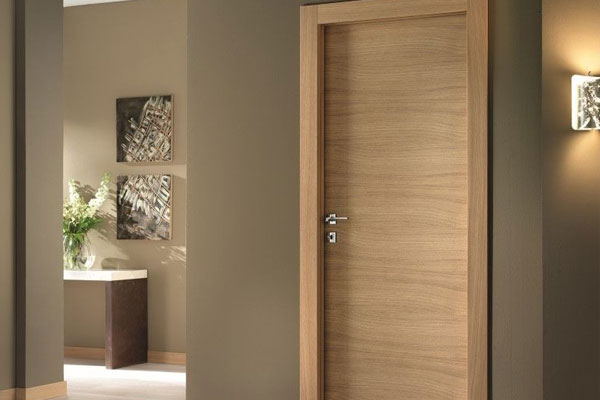
Veneer doors are a popular choice for modern homes, combining natural beauty with practical durability. Made by bonding a thin layer of natural wood veneer to a core material, these doors provide the elegance of solid wood without the high cost. Veneer doors are versatile, offering a wide variety of wood types and finishes that suit various interior styles. In this article, we’ll explore what makes veneer doors unique, their types, benefits, and key factors to consider when choosing veneer doors for your home.
What are Veneer Doors?
Veneer doors consist of a central core made of solid wood, engineered wood, or MDF (medium-density fiberboard), which is then covered with a thin layer of natural wood veneer. This veneer is a high-quality wood slice, typically sourced from oak, walnut, teak, maple, or mahogany. Veneer doors bring the appearance of real wood while being more economical and eco-friendly, as they use less wood than solid wood doors.
Benefits of Veneer Doors
Veneer doors have become popular for both residential and commercial applications. Here are some of the main advantages:
1. Aesthetic Appeal
Veneer doors retain the natural look and texture of real wood, adding warmth and elegance to any room. The variety of wood species and finishes available in veneer doors means you can find a style that matches your decor, from classic to contemporary.
2. Cost-Effective Alternative to Solid Wood
Since veneer doors use less wood, they are more affordable than solid wood doors. They allow homeowners to enjoy the beauty of real wood without the hefty price tag, making them a budget-friendly option for high-end design.
3. Eco-Friendly Choice
Veneer doors are environmentally friendly because they make efficient use of wood. By utilizing thin slices of wood, veneer production minimizes waste and reduces the need to harvest additional trees, making it a sustainable choice.
4. Durability and Stability
The core material used in veneer doors, such as engineered wood or MDF, provides excellent stability, reducing the likelihood of warping or cracking over time. This makes veneer doors more resilient to temperature and humidity changes than solid wood.
5. Versatility in Design
Veneer doors come in a variety of styles, grains, and colors. From light oak and walnut to deep mahogany, you can select a finish that complements your decor. Some veneer doors even incorporate unique grain patterns for a customized look.
Types of Veneer Doors
Veneer doors are available in different types based on their design, construction, and finish. Here are some popular options:
1. Natural Veneer Doors
Natural veneer doors feature a layer of real wood veneer, preserving the wood’s original grain pattern. These doors are popular for their organic look and are often finished with a clear coat to highlight the wood’s natural beauty. They suit both traditional and modern interiors.
2. Engineered Veneer Doors
Engineered veneer doors use man-made veneers designed to mimic the appearance of natural wood grains. They are more consistent in appearance and can be tailored to achieve specific patterns or colors, making them an excellent choice for those looking for uniformity.
3. Flat Panel Veneer Doors
Flat panel veneer doors are known for their sleek, minimalistic design. These doors are ideal for contemporary and modern interiors, as they feature a smooth, flat surface without raised panels or intricate details. Flat panel doors emphasize simplicity and are often used in office settings.
4. Raised Panel Veneer Doors
Raised panel doors feature an elevated central panel, adding dimension and depth to the door’s design. This classic style is ideal for traditional and transitional interiors, providing an elegant, decorative look.
5. Flush Veneer Doors
Flush veneer doors are made with a single, continuous veneer sheet, giving them a smooth and seamless appearance. They are a popular choice for modern interiors, where a clean and uncluttered look is desired.
Factors to Consider When Choosing Veneer Doors
When selecting veneer doors, it’s essential to consider factors like the type of wood veneer, finish, durability, and maintenance requirements. Here are some tips for choosing the best veneer doors for your space:
1. Type of Wood Veneer
The type of wood veneer significantly impacts the appearance and durability of the door. Choose a wood species that aligns with your style and maintenance preferences. Oak, walnut, and mahogany are popular choices for their rich color and distinct grain patterns.
2. Core Material
The core material determines the door’s weight, durability, and resistance to temperature changes. Solid wood cores are durable but can be heavy, while MDF or engineered wood cores are lighter and more stable in varying climates.
3. Finish and Coating
The finish on a veneer door enhances its appearance and protects it from wear. Choose a finish that complements your interior design and suits the door’s intended use. Glossy finishes add a polished look, while matte or semi-gloss finishes offer a more natural appearance. Look for finishes that provide UV protection if the door is exposed to sunlight.
4. Durability and Maintenance
Different wood species have varying levels of hardness and durability. Hardwoods like oak and walnut are scratch-resistant and ideal for high-traffic areas, while softer woods may require more maintenance. Regular cleaning and occasional polishing will keep the veneer looking fresh and well-maintained.
5. Style and Compatibility
Veneer doors come in numerous designs, from sleek and modern to classic and traditional. Consider the architectural style of your home when selecting a design. Modern homes benefit from flush or flat-panel veneer doors, while traditional interiors may look best with raised panel designs.
6. Price and Budget
Veneer doors range in price depending on the wood species, core material, and finish. Set a budget that aligns with your needs, keeping in mind that high-quality veneer doors may offer better durability and visual appeal in the long run.
Veneer Door Maintenance Tips
Proper care and maintenance can help prolong the life of veneer doors. Here are some simple maintenance tips:
1. Dust Regularly
Dust veneer doors regularly with a soft, dry cloth to prevent the buildup of dust and grime. Avoid using abrasive cloths or harsh cleaners, which may damage the veneer finish.
2. Avoid Moisture Exposure
Avoid placing veneer doors in areas with high humidity, as moisture can weaken the veneer bond over time. Use a dehumidifier in humid areas and avoid cleaning with excess water.
3. Use Wood-Appropriate Cleaners
Use cleaners specifically formulated for wood surfaces. Avoid ammonia-based products or heavy-duty cleaners, as they can strip the finish and dull the appearance of the wood veneer.
4. Polish Periodically
Periodically polish veneer doors with a high-quality furniture polish to restore their shine and protect the finish. Apply a thin, even layer and buff gently to enhance the door’s natural beauty.
Popular Applications of Veneer Doors
Veneer doors are versatile and can be used throughout the home. Here are some common applications:
1. Interior Room Doors
Veneer doors are frequently used as interior room doors due to their aesthetic appeal and affordability. They enhance the look of bedrooms, living rooms, and dining areas, adding warmth and sophistication.
2. Office Doors
In offices, veneer doors add a professional and upscale touch to meeting rooms, executive offices, and reception areas. The variety of wood veneers allows companies to customize the look to match their brand image.
3. Wardrobe Doors
Veneer doors make excellent wardrobe doors, as they provide a stylish, finished look and blend well with other wood furniture in the bedroom. Flat-panel veneer doors are particularly popular for contemporary wardrobe designs.
4. Kitchen and Cabinet Doors
Veneer doors are also used in kitchens for cabinet doors, providing a cohesive and refined look. They work well with both modern and traditional kitchen designs, depending on the choice of wood veneer and finish.
Conclusion
Veneer doors offer a unique blend of style, durability, and affordability, making them an ideal choice for both residential and commercial spaces. With a wide variety of wood types, finishes, and designs available, veneer doors cater to diverse preferences and design styles. By selecting the right veneer, core material, and finish, you can find a door that enhances your interior decor and stands up to daily use. Whether you prefer a classic raised panel design or a minimalist flush finish, veneer doors are a versatile and stylish solution for any home.












